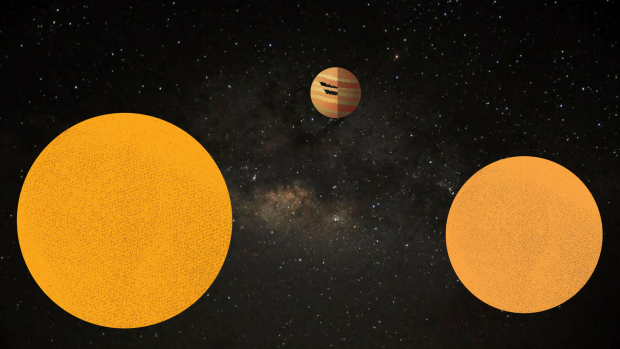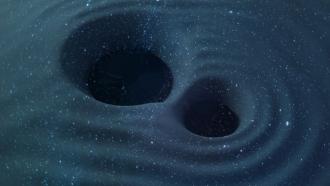
Illustration: Siddharth Kankaria / Research Matters; Background photograph: Seshadri KS
“Data will talk to you if you’re willing to listen to it”, said Jim Bergeson – a well known computer engineer. And that’s probably what scientists from Raman Research Institute (RRI), Bangalore, and Hans Raj College, University of Delhi, seem to have done. While combing through data on orbit of a binary system of star (MXB 1658-298), collected over a 40 years, 1976-2016) period, they have noticed discrepancies in the orbital period of these stars. They attribute this to an invisible ‘third’ object, probably the most massive planet revolving around a binary star, which we have ever known.
In a binary system of stars, two stars orbit each other and in some cases, one of the stars in the binary is a compact star, like a neutron star or a black hole that accretes matter from its companion. In the case of MXB 1658-298, an eclipsing X-ray binary star system, the massive star is believed to be a very dense neutron star, which is actively eating up material from its companion, making it interesting for scientists to study. This system of stars has now become even more appealing after scientists involved in this study discovered discrepancies in the time between the X-ray eclipses.
While comparing observational data obtained from several X-ray telescopes, during three active periods of the binary stars between 1976 to 1978, 1999 to 2001, and 2015 to 2016, the researchers found that the time between X-ray eclipses did not match theoretical predictions. Instead, there appeared to be an invisible force affecting the orbital period of the stars. The invisible force, they think, might be a massive planet (around 20 to 25 times the mass of Jupiter) orbiting the stars. “This work didn’t start as a search for an exoplanet. We were studying the evolution of this X-ray binary – MXB 1658-298. We were just keeping track of the orbital period of the binary”, says Prof. Biswajit Paul, Professor at RRI, explaining the context behind this study.
Detecting a planet around a far-away star can be quite a challenge. When looking through a telescope, the light reflected from the planet is drowned out by the brightness of its parent star or stars, requiring alternate methods to observe them. One way to detect an exoplanet is to measure the dip in the amount of light reaching us, when its orbit is between its parent star and our line of sight from Earth. But in the case of a binary system, knowing the orbital period of the two stars would also help in detecting an exoplanet, as it interacts with the stars through gravity, sometimes changing the orbital period of the stars. For this discovery, the researchers used the latter principle and developed a new technique of measuring the periodic delay in X-rays, to identify the existence of an exoplanet.
“If the arrival of the X-ray eclipses slows down, then it means the orbit is expanding and if the eclipses appear faster than expected,, then the orbit is decaying. Such an evolution of the orbit could be because of the mass transfer between the stars. But in this case, in addition to a decay of the orbit we found that the time of the eclipse was oscillating, which means the binary period was slowing down and then speeding up over a two-year period. This is what prompted us to propose that there could be a third body, which is causing the oscillation in the orbital period. Now, by measuring the change in orbital period, we can calculate the mass of the third body”, explains Prof. Paul.
Although not conclusive, the prediction now opens up new avenues of study on MXB 1658-298. “While there are more than 2000 exoplanets that are known, only 20 ‘circumbinary’ planets (planets that revolve around binary stars) have been discovered. This one is the most massive, it is at a great distance from us, and it is around a LMXB (Low Mass X-ray Binary), which are usually very old systems. So it would be very interesting to study this system further”, signs off Prof. Paul, talking about the enthusiasm this study has created.






